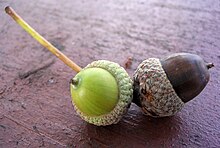Barochory
A propagation mechanism of plants that makes use of the force of gravity is called a barochory . It is a variant of the topochory (close range).
Barochory is particularly typical of many deciduous trees, whose ripe fruits detach from the fruit stalk and fall to the ground due to gravity. Oaks and hazelnut bushes , for example, use this propagation mechanism. But it is also used by smaller plants. In the wild strawberry, the fruits that are not consumed by animals or humans and thus spread endochorically dry up on their fruit stalks. The nuts then fall from the withered fruits to the ground.
Expressions
The few plants in which the capsules break open when they fall and the seeds roll a few meters further due to the energy released are referred to as gravity migrants. This applies, for example, to the common horse chestnut .
In addition to the real barochory, i.e. the simple fall of individual, naked and heavy seeds by gravity from a fruit that remains on the mother plant, there are a few other forms:
- In the case of the calycobolia , the calyx that surrounds the fruit breaks off from the rachis as the fruit ripens and the whole fruit falls to the ground. Here it can be blown away or remain with heavy fruits.
- In synaptospermia , it is not a single fruit that falls down, but the entire inflorescence with several fruits. To do this, he breaks off the stem axis. These pods are usually too heavy to blow away.
- In aestatiphoria , the fruit does not fall at all until the plant disintegrates. Here the fruit remains closed.
- Basikarpie is the case in which the heavy fruits press the inflorescence to the ground and germinate there.
- Finally, geocarpy is a special phenomenon in which some sterile flowers are transformed into bores that enclose the fertile flowers and penetrate the soil. There the fruits ripen and the seeds can germinate.
It also includes real and fake viviparia .
literature
- Angelika Lüttig & Juliane Kasten: Rose hip & Co - flowers, fruits and spread of European plants. Fauna Verlag, Nottuln 2003, ISBN 3-93-598090-6
